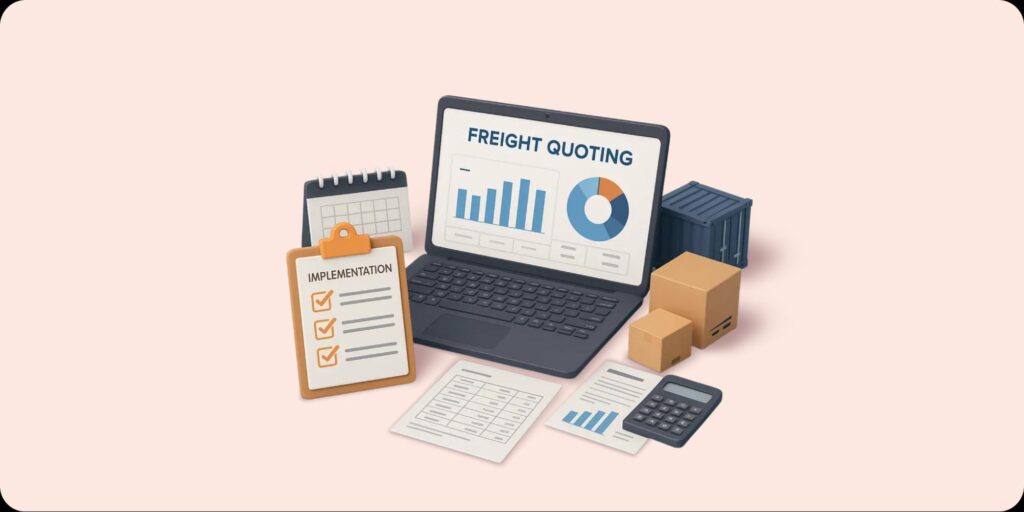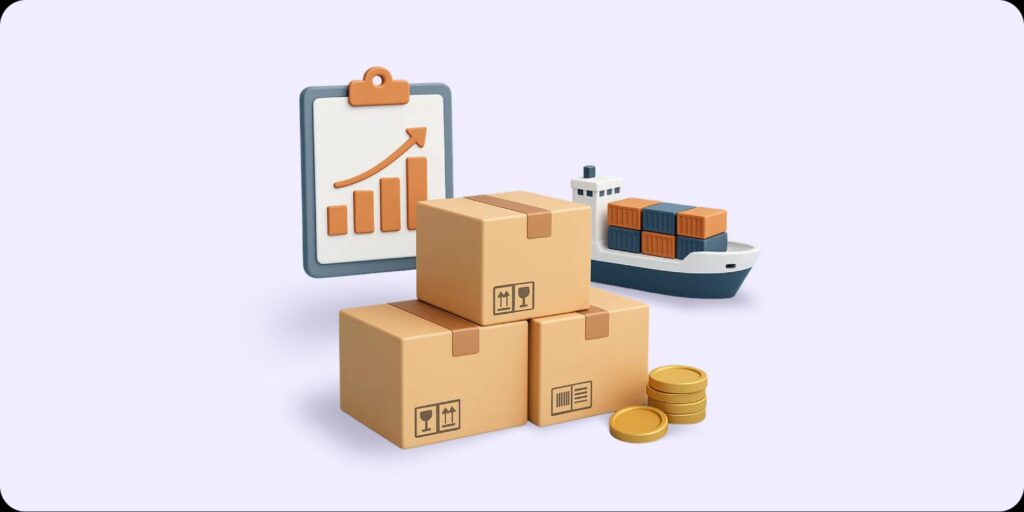Key Takeaways
- Automating quoting, booking, and tracking with platforms like Wisor speeds up operations, reduces errors, and improves customer satisfaction.
- Real-time rate procurement and AI-powered optimization drive cost savings and faster decision-making across the logistics chain.
- Automation eliminates manual bottlenecks in documentation and stakeholder collaboration, enabling higher shipment volumes and smoother cross-border operations.
- Key challenges include integrating with legacy systems, training staff, and securing sensitive data, but phased rollouts and clean data mitigate risks.
- Wisor reduces quote turnaround by 85%, eliminates spreadsheet friction, and scales freight operations with a cloud-native, end-to-end logistics automation platform.
Global trade runs on the seamless movement of goods, and logistics automation is quickly becoming the backbone of efficient logistics operations. In many cases, companies using AI report automating up to half of their repetitive logistics tasks, improving efficiency by around 30–40% and significantly cutting manual labor input, according to industry analyses and broader logistics benchmarks.
Over 70% of North American warehouses already use AI-powered warehouse management systems. Amazon, for example, has deployed more than 750,000 robots across its global operations.
With these shifts in motion, it’s essential to understand how automation in logistics is reshaping the industry, and how platforms like Wisor are empowering freight forwarders to scale operations faster and more efficiently.
What is Automation in Logistics?
Automation in logistics means using digital tools and automated systems to perform tasks that were once manual, like booking, documentation, cargo tracking, and warehouse operations. The goal isn’t to eliminate human input but to streamline and scale logistics processes with higher accuracy and speed. It typically involves:
- Warehouse Automation: Technologies like robotics, conveyors, and warehouse management systems for efficient movement and storage of goods.
- Digital Workflow Automation: Platforms like Wisor automate quoting, customs, and updates, connecting carriers and clients in real-time.
- AI-Powered Optimization: AI helps improve inventory management and supply chain routing for reduced costs and faster decision-making.
The shift to logistics automation has been accelerated by AI, transforming traditional operations into intelligent, scalable systems that minimize errors and lower operational costs. While a person may manage a few shipments a day, automation allows thousands to be handled simultaneously, making it easier to grow in a global market.
Manual vs. Automated Logistics Workflows
To better understand the value of logistics automation, it is beneficial to compare manual and automated workflows and how these two differ from one another:
| Factor | Manual Workflows |
Automated Workflows |
| Time and Cost | Rate requests often take hours or days to complete. This increases labor and process costs. | Requesting and processing are performed in seconds. This cuts delays and reduces operational costs. |
| Error Rates and Rework | High risk of errors from manual data entry, resulting in poor inventory management. Errors can cause the need for rework and shipment delays. | Data validation is a built-in feature in many logistics automation softwares. This lowers errors and avoids rework. |
| Customer Satisfaction | Customers wait longer to get updates. They have limited input on the shipment status. Poor customer satisfaction overall. | Real-time tracking and transparent logistics processes improve customer satisfaction. |
| Scalability | Manual tasks become bottlenecks as the volume rises. It becomes hard to expand and grow. | Logistics automation scales these processes easily. Automated warehouses and workflows boost scalability and growth. |
Benefits of Automation in Logistics
Automating logistics processes not only streamlines operations but also creates a measurable impact across every stage of the supply chain. Key benefits include:
- Faster Quoting and Booking: Modern quoting tools like Wisor enable freight forwarders to generate instant, real-time quotes by pulling data from multiple carriers. This accelerates response times, increases win rates, and allows forwarders to capture high-demand shipments before competitors.
- Lower Operational Costs: Automation reduces the need for manual data entry, phone-based coordination, and spreadsheet-driven workflows. It cuts overhead costs, improves resource allocation, and allows logistics teams to scale output without scaling headcount.
- Real-Time Shipment Tracking and Visibility: Automated systems provide live tracking updates across every stage of the shipment lifecycle. This improves supply chain transparency, keeps customers informed, and allows teams to proactively address delays or disruptions.
- Better Experience for Customers and Partners: Automation eliminates errors, ensures timely updates, and creates a more consistent experience for shippers, clients, and ecosystem partners. It enhances communication and fosters stronger relationships through improved visibility and responsiveness.
- Easier Scaling for Global Trade: With automated quoting, digital booking, and AI-optimized routing, businesses can handle higher shipment volumes and expand into global markets without operational bottlenecks. This sets the foundation for long-term growth.
6 Key Use Cases of Logistics Automation
Logistics automation is transforming warehouse operations by enabling end-to-end workflows with minimal human input. Below are six core use cases showing how businesses apply it in real-world freight and logistics processes:
1. Automating Quoting and Rate Management
Modern freight platforms leverage logistics automation to pull live rates from carriers, contracts, and spot markets, instantly generating accurate quotes. This replaces outdated quoting methods and allows freight forwarders to respond faster, reduce errors, and improve customer satisfaction. For many logistics companies, real-time quoting has become essential to staying competitive in global trade.
2. Streamlining Shipment Lifecycle Management
Managing shipments involves booking confirmations, documentation, customs clearance, tracking, and delivery updates. Automation ties all of these together in a single, synchronized workflow. When a booking is made, it can automatically trigger documents, update tracking statuses, and notify customers in real time, eliminating silos and bottlenecks across the supply chain.
3. Reducing Manual Data Entry in Documentation
Documentation is a massive part of logistics, involving forms like the bill of lading, commercial invoices, and customs declarations. Manual data entry is error-prone and time-consuming. Automated systems now use OCR and AI to extract, validate, and enter this data into connected systems, ensuring accuracy, speeding up processing, and improving compliance.
4. Improving Collaboration Across Supply Chain Stakeholders
The supply chain includes many parties – shippers, carriers, forwarders, customs brokers, and customers – often working across disconnected systems. Automation platforms create a shared digital environment, allowing all stakeholders to access real-time information, communicate clearly, and avoid delays or miscommunication.
5. Supporting Multimodal and Cross-Border Logistics
Handling sea, air, and land transport, especially across borders, requires careful coordination. Automated tools integrate scheduling, regulatory data, and cost tracking across different transport modes. This simplifies compliance, accelerates execution, and reduces operational costs.
6. AI-Powered Route and Rate Optimization
AI-driven systems analyze data such as traffic, weather, fuel prices, and carrier performance to recommend optimal routes and rates. This ensures timely deliveries at lower costs. In warehouse operations, AI also improves picking, packing, and inventory allocation, maximizing space and minimizing delays.
Challenges of Automation in Logistics
Adopting automation in logistics offers clear advantages, but it also introduces important challenges that businesses must anticipate:
- Integrating with Legacy Forwarder Systems: Many logistics companies still rely on outdated software that wasn’t designed for modern automation. Integrating new systems into these legacy environments often requires technical customization, data migration, and time-intensive support, making it one of the biggest hurdles to full automation.
- Employee Adoption and Training Needs: Introducing new automation technologies means changing how teams work. For employees accustomed to manual processes, this can create resistance. Training programs, strong onboarding, and gradual rollouts are essential to drive adoption, especially among experienced staff who may be unfamiliar with cloud tools.
- Data Security and Privacy Concerns: Automated logistics systems handle sensitive data, including shipping details, customer records, and financial documents. If improperly secured, these systems can become targets for cyberattacks or data breaches. Businesses must ensure that any platform they adopt includes encryption, secure storage, and regulatory compliance.
- Cost Barriers for Heavy Tech Investments: While automation can reduce long-term operational costs, the initial setup – whether for warehouse automation hardware or subscription-based platforms – can be expensive. Small and mid-sized forwarders may find it hard to justify the upfront investment without a clear, short-term ROI.
Good to Remember
Automation without clean rate data leads to quote rework, pricing errors, and customer churn. Always prioritize structured carrier contracts and standardize inputs first.
Best Practices for Automation in Logistics
To succeed with automation in logistics, companies need more than just the right tools – they need a strategic approach. Implementing best practices around integration, training, security, and measurement ensures the transition is smooth, scalable, and sustainable.
These practices help unlock the full potential of automation technologies and give companies a significant edge in today’s competitive freight landscape:
|
Best Practice |
How It Helps Logistics Operations |
| Start with High-Impact Processes | Focus on workflows with the most repetitive tasks or errors. For example, quoting or documentation. This will build wins and gain momentum for wider adoption. |
| Integrate Systems Early | Connect TMS, WMS, ERP, and customer portals to avoid silos. With integrated platforms, you will reduce duplicate data entry and improve visibility. |
| Prioritize Data Quality | Make sure that the data is clean and accurate before starting with automation. Poor data leads to errors down the line that are difficult to fix. |
| Adopt a Phased Approach | Roll out automation in steps instead of all at once. This move will reduce risk and will give the teams time to adapt to the new changes. |
| Train and Upskill Staff | Invest in employee training. Employees need to understand the new tools and workflows. Training is essential in order for the operation to run smoothly. |
| Leverage AI and Analytics | Use AI for insights in demand forecasting, route optimization, and inventory planning. With AI, you can measure ROI and refine automation strategy. |
| Monitor and Continuously Improve | Track your KPIs. These include the processing time, error rates, and cost savings. With regular reviews, you can ensure that the automation stays aligned with the business’s goals. |
Automating Freight Forwarding for Faster, Smarter Global Trade with Wisor
Wisor is redefining logistics automation by giving freight forwarders a digital-first platform to scale smarter and ship faster. Here’s how Wisor empowers teams across the freight lifecycle:
- Automated Freight Rate Procurement: Wisor continuously pulls rates from multiple carriers, contracts, and spot markets, automatically comparing and updating pricing in real time. This ensures forwarders always have access to the most competitive rates while reducing errors from manual entry.
- One-Click Freight Booking and Management: By eliminating email chains and spreadsheet friction, Wisor allows users to book shipments instantly through a centralized interface. Teams can manage booking confirmations, updates, and status tracking, all in one place, improving speed and customer satisfaction.
- Workflow Automation to Reduce Manual Tasks: Wisor automates repetitive tasks such as paperwork generation, shipment tracking updates, customer notifications, and exception handling. This frees up operational teams to focus on customer service, strategic planning, and exception resolution.
- Full Visibility and Control for Forwarders: The platform provides real-time visibility into shipment data across lanes, transport modes, and logistics partners, enabling forwarders to track performance, catch issues early, and optimize operations.
- Scalable SaaS Solution for Global Trade: Built as a cloud-native SaaS solution, Wisor enables forwarders to scale across geographies and partners without requiring costly infrastructure investments. It’s flexible, modular, and designed to grow with your business.
With Wisor, freight forwarders move beyond spreadsheets, outdated tools and manual bottlenecks, unlocking a faster, more accurate, and scalable way to manage global trade.
Conclusion
Automation in logistics is reshaping the global freight landscape. From warehouse automation to AI-powered route planning, companies adopting these tools are gaining the speed, efficiency, and scalability needed to thrive in modern trade.
While challenges like system integration and training exist, the long-term rewards far outweigh the hurdles. With the right platform and strategy, automation becomes a competitive advantage.
Explore how solutions like Wisor can simplify your freight operations and unlock new opportunities for growth.








